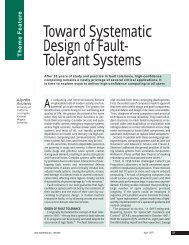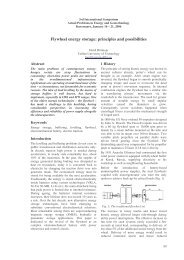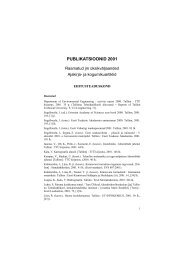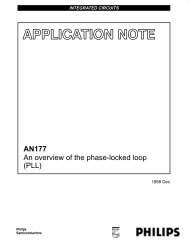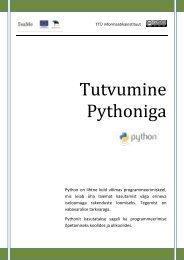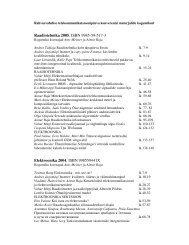Digital Receiver Handbook: Basics of Software Radio
Digital Receiver Handbook: Basics of Software Radio
Digital Receiver Handbook: Basics of Software Radio
You also want an ePaper? Increase the reach of your titles
YUMPU automatically turns print PDFs into web optimized ePapers that Google loves.
<strong>Digital</strong> <strong>Receiver</strong> <strong>Handbook</strong>: <strong>Basics</strong> <strong>of</strong> S<strong>of</strong>tware <strong>Radio</strong>Theory <strong>of</strong> OperationDSP Demodulation FunctionsKey ey Benefits <strong>of</strong> <strong>Digital</strong> <strong>Receiver</strong>s● Frequency and Phase Shift Keying (FSK, PSK)● AM, FM, and PM● Spread Spectrum● Custom Frequency Agile Schemes● Signal Analysis (FFT’s), Signal Identification● Signal Recording and Tracking●●Dedicated digital receiver hardwarepreselects only signals <strong>of</strong> interestSaves significant DSP horsepowersince DSP requirements are directlyproportional to sampling rateFigure 19 Figure 20Virtually any form <strong>of</strong> demodulation can be implementedjust by loading the DSP or FPGA with theappropriate algorithm (Figure 19). AM can be demodulatedwith an envelope detector, FM & PM can bedemodulated using a phase or frequency discriminatoralgorithm.The ability to quickly change the local oscillatorallows frequency-agile modulation schemes to beaccommodated as well. Analysis functions includeenergy detection such as required by scanning receiversthat may be implemented with an FFT, for example.Other analysis functions include cryptography,identification <strong>of</strong> transmitters based on transmissionfrequency, modulation schemes, and other signalcharacteristics.Once the signal is successfully brought into the DSParena, automated functions such as center frequency andbandwidth tuning can be implemented to track a complexsignal which may be moving or hopping. Interestingsignals can be stored on hard disk, tape or other mediaand the time <strong>of</strong> the signal event can be logged as well.With this arrangement, when new or proprietarydemodulation, processing, or analysis schemes are required,no new hardware is necessary. Instead, a new DSP s<strong>of</strong>twarealgorithm is loaded.Think <strong>of</strong> the digital receiver as a hardware preprocessorfor DSP. It preselects only the signals you are interestedin and removes all others. This provides an optimumbandwidth and minimum sampling rate into the DSP.Since the number <strong>of</strong> DSPs required in a system isdirectly proportional to the sampling rate <strong>of</strong> inputdata, by reducing the sampling rate you can dramaticallyreduce the cost and complexity <strong>of</strong> the DSP systemthat follows.Even if the digital receiver outputs do not require agreat deal <strong>of</strong> signal processing, reduction <strong>of</strong> bandwidthand sampling rate helps save time in data transfers toanother subsystem, helps minimize recording time andtape or disk space, and speeds up communication channels.12Pentek, Inc. • One Park Way, Upper Saddle River, NJ 07458 • Tel: (201) 818-5900 • Fax: (201) 818-5904 • Email: digrec@pentek.com • http://www.pentek.com




